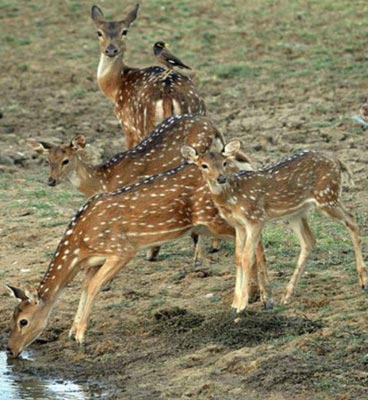Safari Zones in Satpura
Satpura National Park, nestled in the Hoshangabad district of Madhya Pradesh, is a pristine wildlife sanctuary. The national park is named after the Satpura Range and is known for its rugged terrain, dense forests, and rich flora and fauna. It serves as a habitat for a wide range of wildlife, including tigers, leopards, sloth bears, Indian bison, and multiple species of birds. Satpura National Park’s stunning scenery, marked by towering hills, deep ravines, and the calm waters of the Denwa Backwater, makes it a haven for nature lovers and wildlife enthusiasts.
Jeep safaris in Satpura National Park are popular for venturing into the core and buffer zones, providing opportunities for wildlife sightings in their natural habitats. In addition to jeep safaris, the park also offers boat safaris on the Denwa River and walking safaris, making it one of the few parks in India where visitors can explore on foot. The core zones are ideal for wildlife viewing, while the buffer zones allow for a more tranquil experience, often highlighting the lesser-known beauty of the park. The best time to visit Satpura National Park is between October and April, when the weather is pleasant, and wildlife sightings are frequent, making it an ideal time to plan a safari adventure.


Core Zones
The Core Zone of Satpura National Park is the protected central area of the forest, where human interference is strictly prohibited. Limited tourism activities are allowed in this zone, with a complete ban on the extraction of any forest resources. The primary objective of these restrictions is to safeguard wildlife from poaching and preserve the forest ecosystem, ensuring animals thrive in their natural habitat. There are three Core Zones in Satpura National Park that share their boundaries with the buffer region of the national park.
Madhai - The Madhai Gate is the most popular entry point to Satpura National Park, offering diverse topography that includes plains, valleys, meadows, water bodies, and hilly terrains. This zone is renowned for having the highest density of tigers, making it the focal point for wildlife tourism within the park. To maintain ecological balance and minimize human impact, only 30 vehicles are allowed to enter this core zone each day, divided between the morning and afternoon safari slots. An additional attraction in the Madhai Zone is the boat safari on the Denwa Backwater, which also facilitates the sighting of tigers and other wild animals.
Churna - The Churna Gate, also referred to as the Bheemkund Safari Gate, is situated within the core zone of Satpura National Park, located in the western region of the reserve. It can be conveniently accessed via both the Madhai and Bheemkund entry gates, depending on the current safari conditions. This area is known for a relatively higher frequency of tiger sightings, as it forms part of the critical tiger habitat.
Pachmarhi (Panaarpani) - This zone is relatively a new addition to the core region of Bandhavgarh National Park. Commonly referred to as the 'Panaarpani Zone,' this zone is situated near the popular Pachmarhi Hill Station, attracting a large number of eco-tourism visitors. Tourists wishing to experience a jungle safari must travel approximately 8 km from the hill station. In accordance with regulations, only 7 vehicles are permitted entry during the morning safari and an additional 7 vehicles in the evening. The zone remains closed for safaris every Wednesday during the evening round, ensuring sustainable tourism practices.
Buffer Zone
The buffer zone of Satpura National Park borders and surrounds the core zone, acting as a protective barrier between the national park’s wildlife and the human populations of nearby villages. Unlike the core zone, regulated activities, including limited human habitation, are permitted within the buffer zone. Although wildlife density is lower here compared to the core zone, the buffer zone remains open to tourists year-round, offering a unique advantage. Visitors to this area can encounter a variety of fauna, including chinkara, nilgai, wolves, and the four-horned antelope.
Parsapani - This zone can be accessed through private vehicle safaris, with a limit of 14 vehicles permitted in the morning and another 14 in the afternoon. The terrain here is notably diverse, featuring rich vegetation within an undulating landscape. Visitors can explore a range of natural features, including streams, ponds, grasslands, riverbanks, and dense forests, all contributing to the zone's unique and scenic environment.
Jamani Devi - This zone boasts a scenic landscape with ponds, streams, forests, and riverbanks, offering a picturesque setting for visitors. A range of activities can be enjoyed here, such as camping, trekking, birdwatching, jeep safaris, village tours, and cultural programs, enhancing the overall visitor experience. Safaris in this zone are available through private vehicles, with a limit of 14 vehicles allowed in the morning and 14 in the afternoon, ensuring a regulated and immersive expedition through the area.
Sehra - The Sehra Zone is located in the south-western part of Satpura National Park. Although the tiger count is comparatively low, tourists visiting this area have a higher chance of spotting species such as leopards, Indian Gaur, mouse deer, Indian crested porcupines, and rusty-spotted cats.
Pathai - The Pathai Zone is nestled very close to Madhai Gate and is in a close proximity to Sohagpur. The Pathai Gate is just 15 km from the Madhai, which enhances its popularity and provides with exotic wildlife experience.



